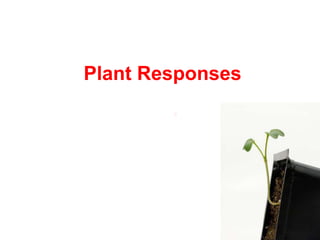Plant responses
•Transferir como PPTX, PDF•
5 gostaram•5,574 visualizações
Denunciar
Compartilhar
Denunciar
Compartilhar

Recomendados
Mais conteúdo relacionado
Mais procurados
Mais procurados (20)
Ecophysiological Effects of Changing Atmospheric Carbon Dioxide Concentration

Ecophysiological Effects of Changing Atmospheric Carbon Dioxide Concentration
Destaque
Destaque (20)
Semelhante a Plant responses
Semelhante a Plant responses (20)
Environmental factors that affecting plant growth]![Environmental factors that affecting plant growth]](data:image/gif;base64,R0lGODlhAQABAIAAAAAAAP///yH5BAEAAAAALAAAAAABAAEAAAIBRAA7)
![Environmental factors that affecting plant growth]](data:image/gif;base64,R0lGODlhAQABAIAAAAAAAP///yH5BAEAAAAALAAAAAABAAEAAAIBRAA7)
Environmental factors that affecting plant growth]
Cultivation,collection, processing,Preservation and Storage of Important Medi...

Cultivation,collection, processing,Preservation and Storage of Important Medi...
7.organic, natural farming By Mr. Allah Dad Khan Visiting Professor Agricu...

7.organic, natural farming By Mr. Allah Dad Khan Visiting Professor Agricu...
Mais de Steve Bishop
Mais de Steve Bishop (20)
Plant responses
- 2. All living organisms are sensitive to changes in their surroundings. Plants are sensitive to light, moisture and gravity. The response to light is called ______________. The response to gravity is called ___________. The response to moisture is called ___________.
- 3. All living organisms are sensitive to changes in their surroundings. Plants are sensitive to light, moisture and gravity. The response to light is called phototropism. The response to gravity is called ___________. The response to moisture is called ___________.
- 4. All living organisms are sensitive to changes in their surroundings. Plants are sensitive to light, moisture and gravity. The response to light is called phototropism. The response to gravity is called geotropism. The response to moisture is called ___________.
- 5. All living organisms are sensitive to changes in their surroundings. Plants are sensitive to light, moisture and gravity. The response to light is called phototropism. The response to gravity is called geotropism. The response to moisture is called hydrotropism.
- 6. •Shoots grow upwards - towards light and against the force of gravity. •Roots grow downwards – towards moisture and in the direction of the force of gravity.
- 12. Commercial Uses of Hormones
- 13. Commercial Uses of Hormones 1. Rooting powder contains auxin. It is applied to cuttings to stimulate the growth of roots. Large numbers of plants can be produced quickly, so more money can be made.
- 14. Commercial Uses of Hormones 1. Rooting powder contains auxin. It is applied to cuttings to stimulate the growth of roots. Large numbers of plants can be produced quickly, so more money can be made. 2. Hormones control fruit ripening. Producers use chemicals to slow down the ripening of fruits, such as bananas, during transport. Just before sale, ripening can then be speeded up using different chemicals and a warmer temperature in the storerooms.
- 15. Commercial Uses of Hormones 1. Rooting powder contains auxin. It is applied to cuttings to stimulate the growth of roots. Large numbers of plants can be produced quickly, so more money can be made. 2. Hormones control fruit ripening. Producers use chemicals to slow down the ripening of fruits, such as bananas, during transport. Just before sale, ripening can then be speeded up using different chemicals and a warmer temperature in the storerooms. 3. Weedkillers contain synthetic hormones that stimulate the plants to grow very rapidly. Their normal growth patterns are disrupted. They become tall and spindly, and eventually die.